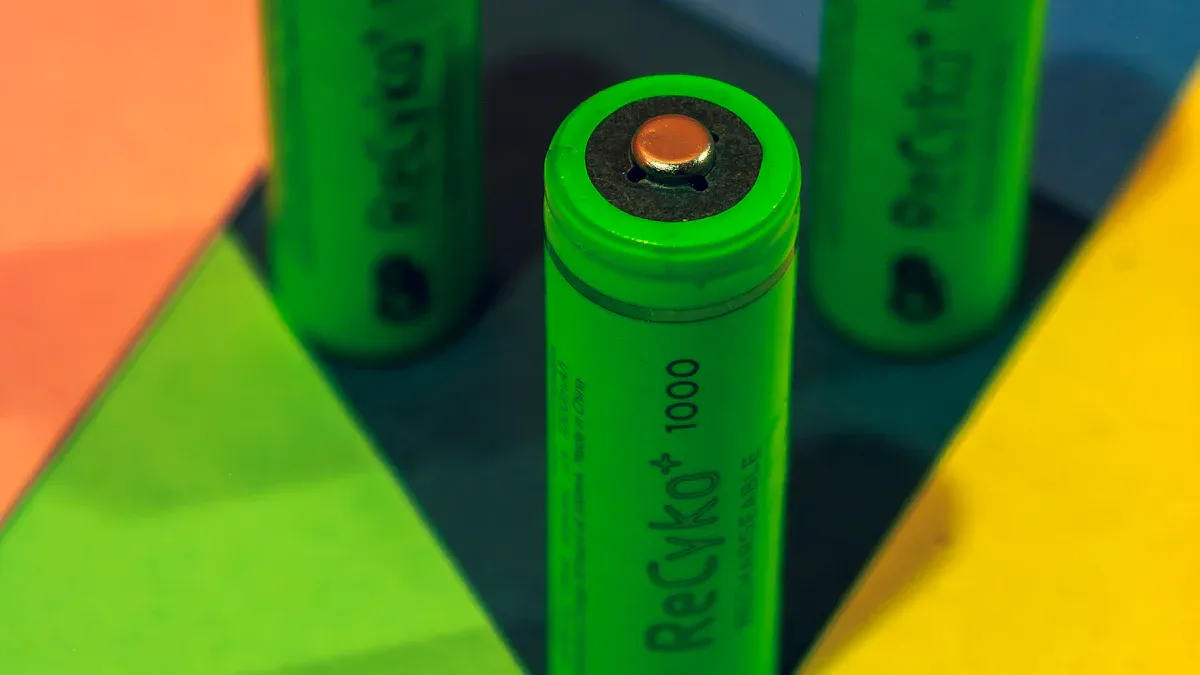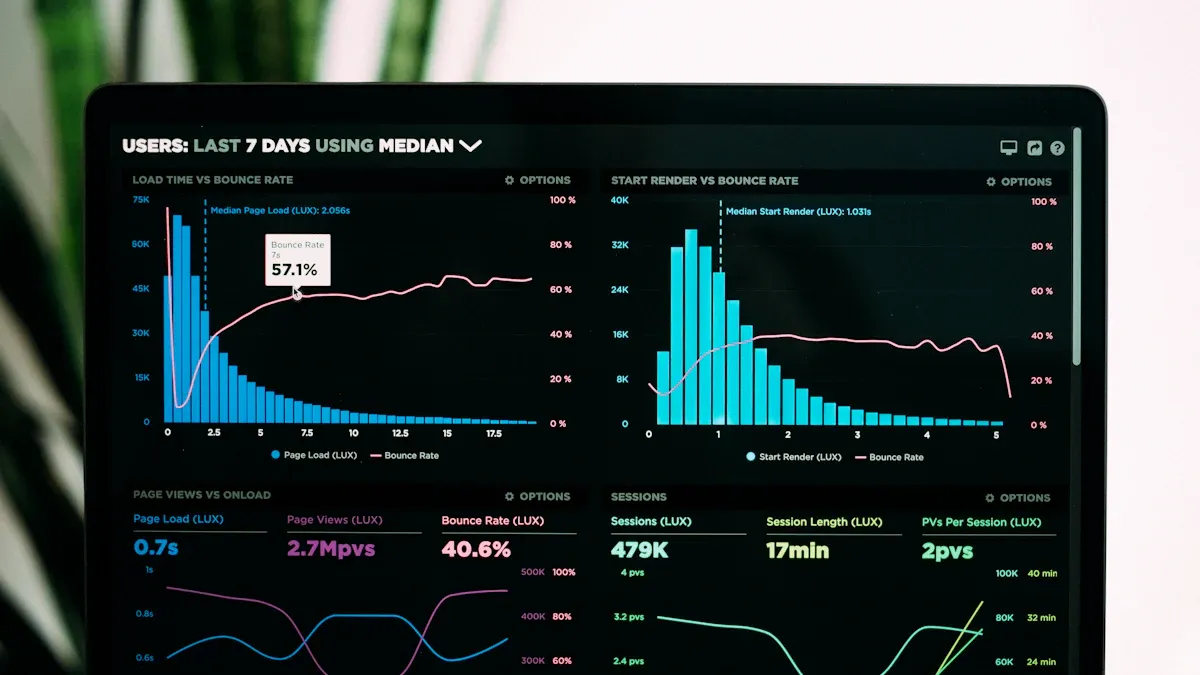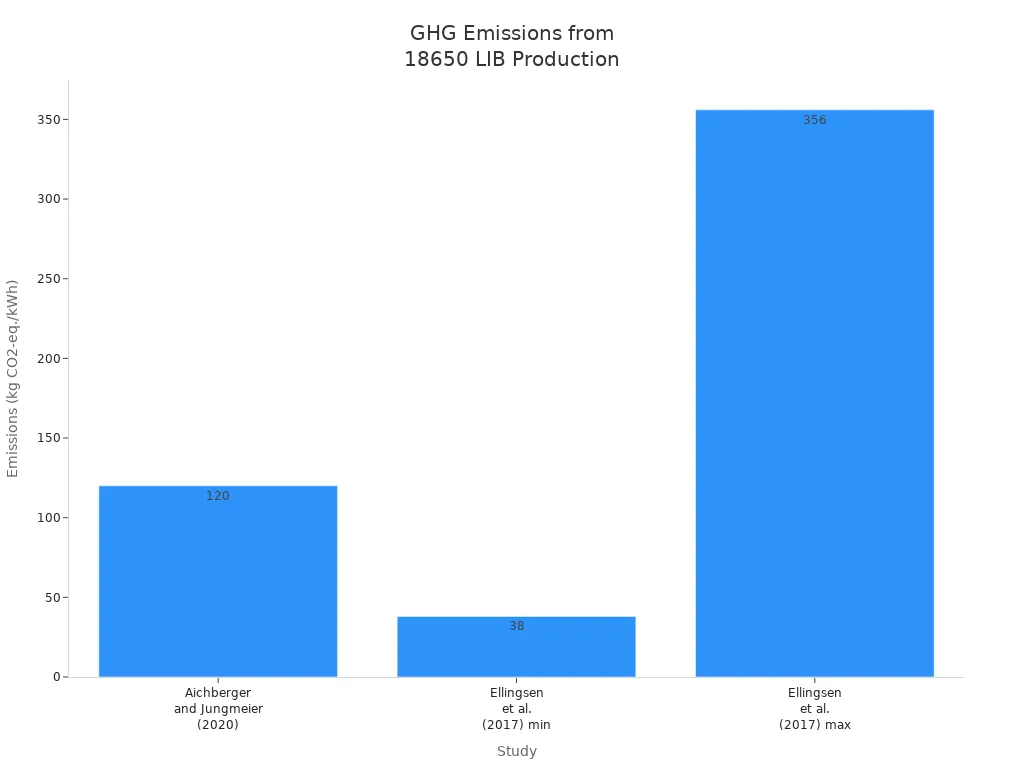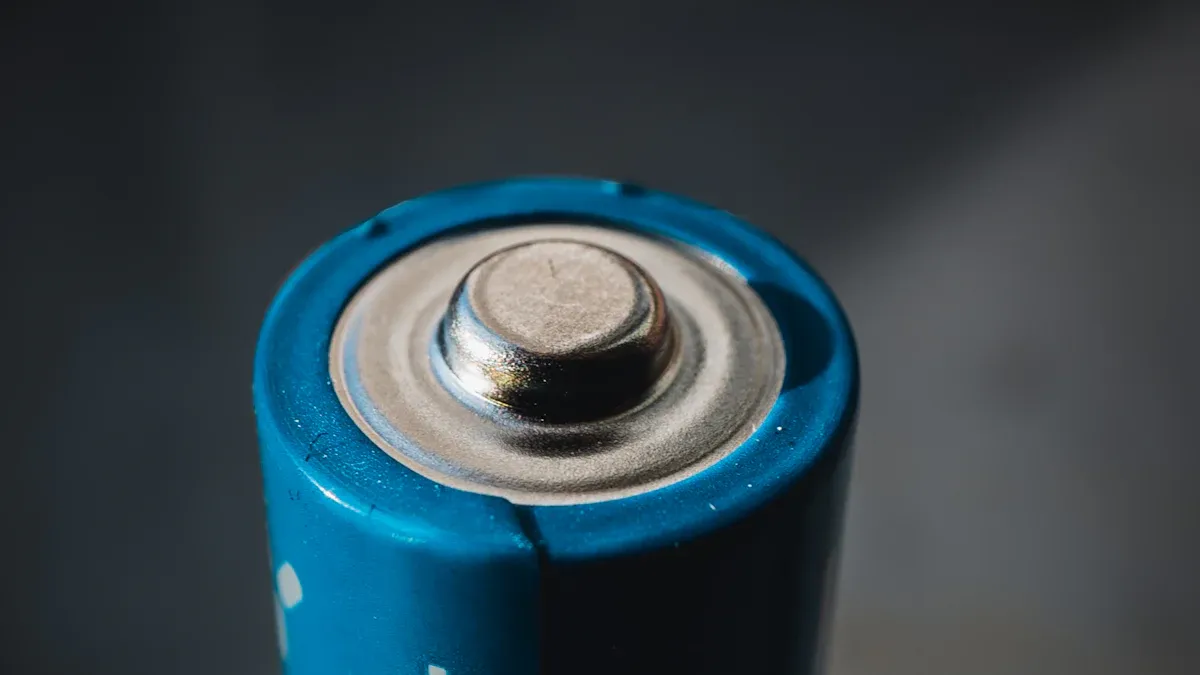Discussion on the development trend of cylindrical 18650 lithium-ion batteries in electric vehicles
You see cylindrical 18650 lithium-ion batteries powering many electric vehicles today. The global market for these batteries reached $38.5 billion in 2024 and could climb to $81.2 billion by 2033.
| Year | Market Size (USD) | CAGR (%) |
|---|---|---|
| 2024 | 38.5 Billion | N/A |
| 2033 | 81.2 Billion | 9.5 |
| 2026-2033 | N/A | 15 (EV segment) |
This strong growth highlights the development trend in electric mobility. You may wonder if these batteries will remain vital in vehicles as technology evolves. The answer is yes—cylindrical 18650 lithium-ion batteries continue to play a key role in electric innovation.
Key Takeaways
- Cylindrical 18650 lithium-ion batteries are crucial for electric vehicles, offering reliability and scalability that manufacturers trust.
- The market for 18650 batteries is growing rapidly, projected to reach $32.6 billion by 2033, driven by the rising demand for electric vehicles.
- While newer battery formats like 21700 and 4680 offer higher energy density, 18650 batteries remain cost-effective and reliable for many applications.
- Advancements in materials and battery management systems enhance the performance and safety of 18650 batteries, benefiting consumers with longer-lasting and safer electric vehicles.
- Despite challenges like lower energy density, 18650 batteries will continue to play a significant role in the electric vehicle market due to their proven track record and ongoing improvements.
Historical Overview
Early EV Adoption
You may remember when electric vehicles first started to gain attention. In those early days, automakers faced many challenges. Battery technology limited how far you could drive on a single charge. Manufacturers needed a battery that offered reliability, safety, and a proven track record. The cylindrical 18650 lithium-ion battery quickly became the top choice.
You saw these batteries first in consumer electronics, such as laptops and power tools. Their success in these products gave automakers confidence. When companies like Tesla entered the EV market, they chose 18650 cells for their first models. The battery’s compact size and consistent performance made it easy to design battery packs with high energy output. You could see how this format allowed for flexible configurations, which helped engineers build larger battery packs for longer driving ranges.
Tip: The 18650 battery’s early adoption in electric vehicles set the stage for rapid innovation in the industry.
Market Presence
Over the past decade, you have witnessed a dramatic shift in the electric vehicle industry. The demand for EVs has soared, driven by stricter emission regulations and a global push for cleaner transportation. As a result, the market for 18650 lithium-ion batteries has expanded rapidly. Manufacturers have focused on improving battery technology, which has led to higher energy density and better performance.
You benefit from these advancements through longer driving ranges and shorter charging times. Companies have also worked hard to reduce costs by streamlining manufacturing and increasing production scale. This makes electric vehicles more affordable and attractive to you as a consumer. Sustainability has become a key focus, with efforts to minimize the environmental impact of battery production and recycling. The strong market presence of 18650 batteries reflects their ability to adapt and meet the evolving needs of the electric vehicle industry.
18650 Battery Advantages

Reliability
You rely on cylindrical lithium-ion batteries for consistent performance in electric vehicles. The 18650 lithium-ion batteries set a standard for reliability in the industry. You notice that these batteries deliver stable energy output, which helps you drive with confidence. Manufacturers choose the 18650 battery because it maintains a predictable cycle life and resists degradation over time. You benefit from fewer breakdowns and lower maintenance costs.
Cylindrical lithium-ion batteries, especially the 18650 format, achieve energy densities around 250 Wh/kg. This level of energy density supports long driving ranges and efficient power delivery. You may compare this to newer formats like the 21700, which reach about 300 Wh/kg. The 21700 batteries offer improved thermal management and longer cycle life, but the 18650 lithium-ion batteries remain a reliable choice for many electric vehicles. You see that the proven track record of the 18650 battery makes it a preferred option for high-performance batteries in demanding environments.
You experience fewer safety concerns with cylindrical lithium-ion batteries. The robust design of the 18650 battery helps prevent overheating and reduces the risk of failure. You trust these batteries to perform well under various conditions, from daily commutes to long-distance travel.
Scalability
You appreciate the scalability of cylindrical lithium-ion batteries in electric vehicle design. The 18650 battery allows manufacturers to create flexible battery packs by combining multiple cells. You see this modular approach in many electric vehicles, where engineers adjust the number of 18650 lithium-ion batteries to meet specific energy requirements.
The rise in battery production faces challenges from manufacturing complexity and sensitivity, causing safety and reliability issues. Poor battery quality and its impacts on battery safety, reliability, and the financial success of cell manufacturing are significant concerns. High-profile safety events in various sectors, including electric vehicles, highlight the risks associated with battery technology, which can jeopardize consumer and regulatory confidence.
You notice that cylindrical lithium-ion batteries offer a balance between scalability and safety. The 18650 battery supports mass production, which helps lower costs and increase availability. You benefit from affordable electric vehicles that use reliable and scalable battery technology. The cylindrical design simplifies assembly and maintenance, making it easier for manufacturers to innovate and improve electric vehicle performance.
18650 Battery Limitations
Energy Density
You notice that lithium-ion batteries in the 18650 format face challenges with energy density. When you compare these batteries to newer cylindrical formats, you see that the 21700 battery offers a clear advantage. The 21700 cell provides higher energy density and greater capacity, especially at high discharge rates. This difference impacts how much energy your electric vehicle can store and deliver.
- The 21700 format allows for a higher energy density potential, which limits the 18650 battery’s competitiveness.
- The 21700 battery has about 50% greater capacity and energy density than the 18650, particularly at discharge rates up to 3.75C.
- Transitioning from a 18650 to a 21700 cell can enhance energy density by over 20%.
You experience the effects of these limitations in real-world driving. The 18650 lithium-ion battery may not support the same high energy density as newer formats, which means you get shorter driving ranges and less efficient power delivery. Manufacturers continue to improve lithium-ion batteries, but the physical size of the 18650 cell restricts how much energy and density they can achieve.
Note: High energy density remains a top priority for electric vehicle designers. You benefit from advances in lithium-ion battery technology, but the 18650 format cannot match the energy density of larger cells.
Packaging
You encounter packaging constraints when manufacturers integrate 18650 lithium-ion batteries into modern electric vehicles. The small size of each battery means you need many cells to build a complete battery pack. This increases the number of interconnections and raises integration costs. You may see higher assembly complexity and lower efficiency compared to larger cell formats.
| Cell Type | Advantages | Disadvantages |
|---|---|---|
| Small Cells (18650) | Higher cost efficiency, lower thermal aging, enhanced safety | Large number of interconnections, higher integration costs, lower efficiency |
| Large Cells | Lower assembly costs, higher efficiency, easier troubleshooting | Higher production costs, lower quality, higher thermal aging rate |
You benefit from the safety and reliability of small lithium-ion batteries, but you also face challenges with packaging and integration. Manufacturers must balance these factors to deliver efficient and cost-effective battery solutions for electric vehicles.
Comparison with New Formats
21700 vs. 18650
You see electric vehicle manufacturers shifting from 18650 batteries to the newer 21700 format. This change happens because 21700 batteries deliver better performance in several key areas. When you compare the two, you notice that 21700 batteries offer higher capacity, which means you get more miles per charge. The energy density of 21700 batteries reaches up to 300Wh/kg, while 18650 batteries typically stay between 200–240Wh/kg. This difference matters for weight-sensitive vehicles and helps you drive farther without increasing battery pack size.
- 21700 batteries provide 1000–2000mAh more capacity than 18650 batteries.
- You experience 30% longer runtime in high-power applications.
- The internal resistance of 21700 batteries is 30–50% lower, so you get better voltage stability during acceleration.
- 21700 batteries run cooler by 7–10°C during fast charging, which improves safety and extends battery life.
Manufacturers choose 21700 batteries for industrial and mid-range EVs because these batteries balance cost, performance, and safety. You may pay a bit more for 21700 batteries, as shown below:
| Battery Type | Price per Cell |
|---|---|
| 18650 cylindrical | $1.20 – $2.00 |
| 21700 cells | $2.00 – $3.50 |
4680 vs. 18650
You notice a growing interest in the 4680 battery format, especially after Tesla introduced it for next-generation electric vehicles. The 4680 battery features a much larger volume than the 18650, which means you need fewer batteries to build a pack. This change simplifies the battery management system and allows for more flexible vehicle designs. The 4680 battery also improves thermal management, which helps prevent overheating and increases safety.
Market trends show that the 4680 format is expanding quickly, with an 18% compound annual growth rate. You see manufacturers adopting 4680 batteries to address range anxiety and improve structural integration. The shift to larger batteries like the 4680 reflects your need for longer range, better safety, and lower complexity in electric vehicles.
Tip: When you choose an EV, consider how battery format affects range, safety, and cost. Newer batteries often deliver better performance, but you should weigh the price and long-term reliability.
Technological Advancements

Materials and Chemistry
You see major improvements in the materials and chemistry of 18650 lithium-ion batteries. Manufacturers now use high-quality materials like graphene and silicon to boost power storage and increase battery capacity. These changes help you drive farther and enjoy better performance from your electric vehicle. NanoGraf’s silicon-oxide anode material raises the capacity of 18650 lithium-ion batteries by 12%. This breakthrough pushes the highest energy density to 800 Wh/L. You could see your electric vehicle’s range increase by up to 28% with this new technology.
| Advancement Type | Description |
|---|---|
| High-Quality Materials | Integration of materials like graphene and silicon to enhance power storage capacity. |
| Energy Density | Increased energy density while maintaining safety and reliability. |
| Fast Charging Technology | Improvements in charging technology to reduce charging time for user convenience. |
| Battery Management Systems | Implementation of intelligent systems to optimize performance and lifespan of batteries. |
You benefit from these advancements because your lithium-ion batteries last longer and deliver more consistent energy. The focus on safety and reliability means you can trust your battery to perform well in different driving conditions. You also notice that new chemistry helps reduce the risk of overheating, which keeps you and your vehicle safe.
Fast Charging
You want your electric vehicle to charge quickly and efficiently. Recent developments in fast charging technology make this possible. Tesla’s V3 Supercharging technology cuts charging times, so you spend less time waiting and more time driving. The move from 18650 to 2170 cells improves energy density and efficiency, but you still see progress in 18650 lithium-ion batteries.
- Tesla’s V3 Supercharging technology significantly reduces charging times, enhancing convenience for EV users.
- The transition from 18650 to 2170 cells has led to improvements in energy density and efficiency.
- These advancements contribute to longer ranges and faster charging capabilities in electric vehicles.
You face challenges with extreme fast charging, such as cathode particle cracking and electrolyte transport limitations. Researchers suggest electrolyte modifications and adaptive fast charging to improve battery performance. Achieving a 10-minute charge under high energy density conditions remains difficult, but ongoing innovation brings you closer to this goal.
- Recent studies have identified key barriers to extreme fast charging, such as cathode particle cracking and electrolyte transport limitations.
- Strategies like electrolyte modifications and adaptive fast charging have been suggested to enhance performance.
- Achieving a 10-minute charge under high energy density conditions remains a significant challenge.
You benefit from these improvements because your lithium-ion batteries charge faster and last longer. Fast charging technology gives you more flexibility and convenience in your daily routine.
Battery Management
You rely on advanced battery management systems to keep your electric vehicle safe and efficient. Innovations in thermal management, such as phase change materials and advanced heat dissipation methods, help prevent overheating and thermal runaway. These features protect your lithium-ion batteries and extend their lifespan.
- Advanced heat dissipation methods are part of the innovations in 18650 lithium-ion batteries, which enhance safety by reducing the risk of overheating.
- The Smart BMS is crucial for enhancing safety and efficiency in 18650 battery applications, acting as a strategic enabler of performance and innovation.
- Innovations in thermal management, such as phase change materials and advanced heat dissipation methods, help prevent overheating and thermal runaway, thus improving safety.
- The Battery Management System for 18650 batteries ensures safety, longevity, and improved efficiency through comprehensive monitoring and protection.
You see smart battery management systems monitoring temperature, voltage, and current in real time. These systems optimize battery performance and protect against damage. You get longer battery life and better reliability, which means fewer worries about breakdowns or safety issues. The focus on battery management helps you enjoy a smoother and safer driving experience.
Tip: You should look for electric vehicles with advanced battery management systems. These systems improve safety, extend battery life, and boost overall performance.
Development Trend
Market Growth
You see the development trend for cylindrical 18650 lithium-ion batteries accelerating in the electric vehicles sector. The market for these batteries continues to expand as more consumers choose electric vehicles for daily transportation. You notice that the market size for 18650 batteries is projected to grow from $8.5 billion in 2023 to $14.8 billion by 2032. This represents a compound annual growth rate (CAGR) of 6.4%. The global market for 18650 batteries is expected to reach $32.6 billion by 2033, with a CAGR of 15.7%. Over half of this demand comes from electric vehicles.
You benefit from this growth because manufacturers invest in better battery technology and production capacity. The automotive battery market itself is projected to grow at a CAGR of over 20% through 2030, driven by the rising adoption of electric vehicles. The International Energy Agency reports that global EV stock surpassed 20 million units in 2022, showing how quickly the industry is evolving.
You can review the following table to understand the market growth for 18650 lithium-ion batteries:
| Year | Market Size (USD) | CAGR (%) | EV Revenue Share (%) |
|---|---|---|---|
| 2023 | $8.5 Billion | 6.4 | 50+ |
| 2032 | $14.8 Billion | 6.4 | 50+ |
| 2033 | $32.6 Billion | 15.7 | 50+ |
You see that the development trend for lithium-ion batteries remains strong. Manufacturers continue to improve battery performance, energy density, and safety features. You experience longer driving ranges and faster charging times as a result of these advancements. The development of new materials and smarter battery management systems also supports this upward trend.
Future Outlook
You can expect future trends in the lithium-ion battery market to shape the direction of electric vehicles. Several factors drive the development trend for 18650 batteries:
- Government regulations promote the adoption of electric vehicles.
- You demand environmentally friendly transportation options.
- Continuous advancements in battery technology lead to improved energy density, longer lifespan, and reduced costs.
- Established manufacturing infrastructure and lower costs make 18650 cells attractive for many applications.
- Competition from newer battery formats, such as prismatic and pouch cells, pushes manufacturers to innovate.
- Sustained growth in EV sales and technological improvements expand the market for lithium-ion batteries.
You see that the development trend for 18650 batteries remains positive, even as new formats enter the market. Advancements in energy density enable longer driving ranges for electric vehicles. Government incentives and regulations support battery research and development, which benefits you as a consumer. Manufacturers focus on sustainability and recycling, making the future trends in battery production more environmentally responsible.
You should pay attention to how these trends affect your choices as an EV owner. The development trend for cylindrical 18650 lithium-ion batteries shows that they will continue to play a significant role in electric vehicles. You benefit from ongoing improvements in battery technology, which deliver safer, more efficient, and longer-lasting batteries.
You see the future trends pointing toward greater integration of advanced materials, smarter battery management, and sustainable manufacturing practices. The development trend for lithium-ion batteries ensures that you will have access to reliable and high-performance energy solutions for your electric vehicle.
Challenges and Opportunities
Competition
You face a rapidly changing landscape in the automotive industry. The lithium-ion battery market grows more competitive each year. You see new battery technologies entering the automotive sector, each promising better performance and safety. Several factors challenge the dominance of 18650 batteries:
- Competition from solid-state battery designs, which offer higher energy density and improved safety.
- Advanced lithium-ion variants that deliver superior performance in automotive applications.
- Volatility in raw material prices, especially lithium and cobalt, which can increase production costs.
- Potential market disruptions that could reduce demand for 18650 battery formats.
You also notice that regulatory trends shape the competitive environment. Manufacturers must meet strict safety and environmental standards, especially in the EU and North America. The following table highlights the regulatory impact:
| Evidence Type | Description |
|---|---|
| Regulatory Impact | Stringent safety and environmental regulations in the EU and North America are compelling manufacturers to adopt sustainable processes and enhance battery safety profiles. |
You must adapt to these changes if you want to stay ahead in the automotive sector. The push for safer, more sustainable batteries drives innovation and shapes your choices as a consumer.
Niche Applications
You still find strong opportunities for 18650 lithium-ion batteries in specialized automotive segments. These batteries remain cost-effective and reliable, making them a preferred choice for certain electric vehicles. You see their continued use in the following areas:
- Electric cars, where the need for efficient and dependable battery solutions remains high.
- Electric bikes, which benefit from the compact size and high power output of 18650 batteries, especially in urban environments.
- Electric scooters, which require efficient battery solutions for frequent daily use.
You benefit from the ongoing expansion of the lithium-ion battery market. The demand for high-energy-density solutions continues to rise. You see that government incentives and the global shift toward cleaner energy support this growth. Improvements in battery management systems and increased production capacities help reduce costs and boost performance. These advancements ensure that 18650 batteries remain relevant and cost-effective for many automotive applications, even as new technologies emerge in the automotive sector.
You see cylindrical 18650 lithium-ion batteries evolving with higher energy density, faster charging, and improved safety. The table below highlights these development trends:
| Development Trend | Description |
|---|---|
| Energy Density Improvements | Ongoing advancements are leading to higher energy density in cylindrical 18650 batteries. |
| Enhanced Charging Speeds | Innovations are enabling faster charging capabilities for these batteries. |
| Safety Features | Increased focus on safety features to address concerns in electric vehicle applications. |
| Market Growth | The electric vehicle sector is projected to grow at annual rates exceeding 10%. |
| Challenges | Issues such as raw material price volatility and safety concerns are being addressed through technology advancements. |
You benefit from reliable battery performance, long cycle life, and robust lithium-ion technology. Manufacturers respond to your demand for longer usage times and sustainability. The chart below shows environmental impacts from different studies:

You can expect 18650 lithium-ion batteries to remain significant in electric vehicles, especially for smaller models and energy storage. Their adaptability and ongoing improvements ensure continued relevance for both consumers and industry stakeholders.
FAQ
What makes cylindrical 18650 lithium-ion batteries popular in electric vehicles?
You see cylindrical 18650 lithium-ion batteries used widely because they offer reliability, scalability, and proven safety. Manufacturers trust this format for consistent performance. You benefit from their long cycle life and stable energy output in your electric vehicle.
How do lithium-ion 18650 batteries compare to newer battery formats?
You notice that newer formats like 21700 and 4680 provide higher energy density and improved efficiency. However, lithium-ion 18650 batteries remain cost-effective and reliable for many electric vehicles. You still find them in smaller EVs and niche applications.
Are lithium-ion 18650 batteries safe for daily use in electric vehicles?
You can trust lithium-ion 18650 batteries for daily use. Their robust cylindrical design helps prevent overheating and reduces failure risk. Manufacturers include advanced battery management systems to monitor safety and extend battery life in your electric vehicle.
Will lithium-ion 18650 batteries remain relevant as technology advances?
You will continue to see lithium-ion 18650 batteries in electric vehicles, especially in smaller models and energy storage. Ongoing improvements in materials, energy density, and safety features help keep this battery format competitive in the market.
What are the main challenges for lithium-ion 18650 batteries in electric vehicles?
You face challenges such as lower energy density compared to larger cells and complex packaging requirements. Despite these issues, lithium-ion 18650 batteries offer strong reliability and remain a practical choice for many electric vehicle applications.
-

 May.2025.11.24Ternary Lithium Battery vs Lithium-ion: Complete Comparison Guide (2025 Edition)Learn More
May.2025.11.24Ternary Lithium Battery vs Lithium-ion: Complete Comparison Guide (2025 Edition)Learn More -

 May.2025.11.214S2P 18650 14.8V Battery: Complete Technical Guide, Specs, Applications & SafetyLearn More
May.2025.11.214S2P 18650 14.8V Battery: Complete Technical Guide, Specs, Applications & SafetyLearn More -

 May.2025.11.18PCM vs BMS in Lithium Batteries: What’s the Difference and Which One Do You Need?Learn More
May.2025.11.18PCM vs BMS in Lithium Batteries: What’s the Difference and Which One Do You Need?Learn More -

 May.2025.11.17Custom Li-ion Battery Design for Medical Devices (2025 Comprehensive Guide)Learn More
May.2025.11.17Custom Li-ion Battery Design for Medical Devices (2025 Comprehensive Guide)Learn More -

 May.2025.11.17The Future of Lithium-Ion Batteries: Innovation, Sustainability, and Global Market TrendsLearn More
May.2025.11.17The Future of Lithium-Ion Batteries: Innovation, Sustainability, and Global Market TrendsLearn More
















